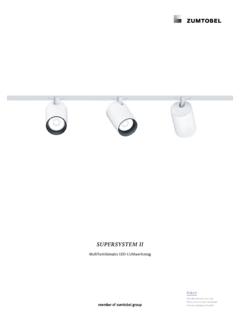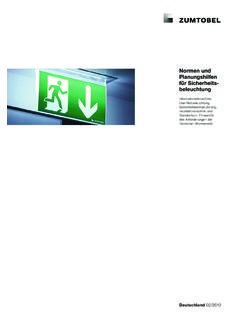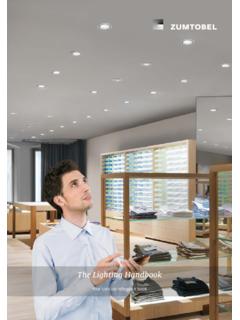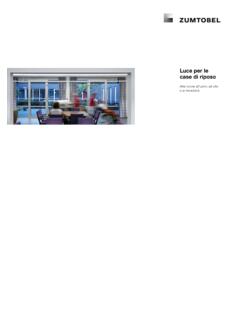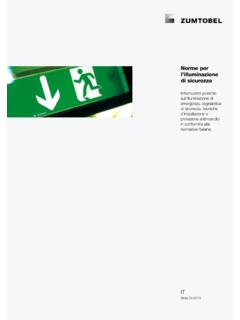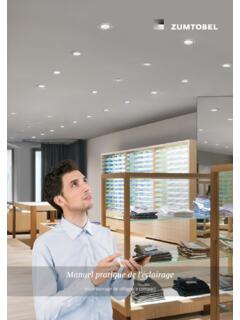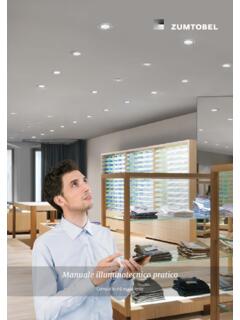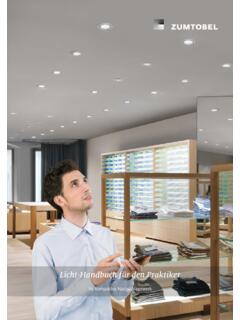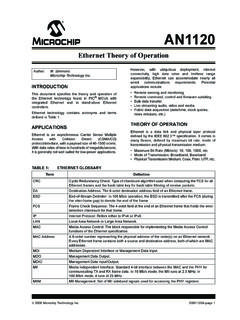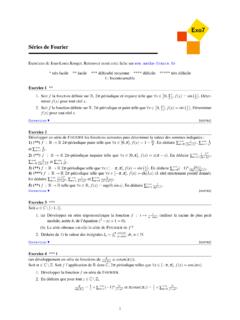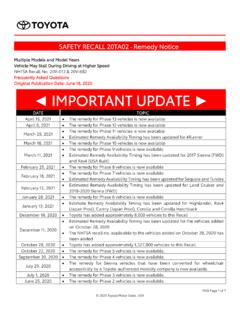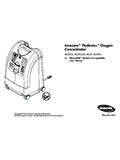Transcription of The Lighting Handbook - Zumtobel
1 The Lighting HandbookYour concise reference bookChapter 2 Standard values for indoor and outdoor lightingBased on the new European standardsChapter 3 Lighting applicationChapter 4 TechnologyChapter 7 Emergency lightingChapter 5 LampsChapter 8 Technology and tablesChapter 9 Design toolsChapter 6 Lighting control and control gearChapter 1 Lighting technologyImprintFor questions and suggestions on The Lighting Handbook Zumtobel Lighting GmbH Schweizer Strasse 30 Postfach 726851 Dornbirn, AUSTRIAT edition: April 2018 The Lighting HandbookChapter 1 Lighting technologyWhat is light? 6 What does the human eye see? 7 Human Centric Lighting 8 Light has a triple effect 8 Basic parameters used in Lighting 10 Luminous flux 11 Luminous intensity 11 Illuminance 11 Lumina n ce 11 Quality characteristics of Lighting The right light traditional and new quality criteria 12 Illuminance definition of terminology 12 Glare glare limitation 14 The UGR method
2 15 Illuminance levels on ceilings and walls 17 Spatial illumination 17 Light colour 18 Colour rendering 18 Measuring illuminance 19 Outdoor Lighting 20 Types of Lighting 22 Lighting concepts 24 Energy efficiency in buildings 2616 The Lighting HandbookLight is that part of the electromagnetic spectrum that is perceived by our wavelength range is between 380 and 780 nm.
3 The cones come on during the day and we see colours, whereas at night the rods take over and we only see shades of is the melanopic effect of light?The retina also contains photosensitive ganglion are sensitive to blue light and suppress the sleep hormone melatonin at night. Melatonin is responsible for a good sleep at night. Suppressing melatonin in the morning helps keep you awake during the day. This means that the right light controls the circadian rhythm thus a healthy waking and sleeping is light?What is light?Wavelength [m]10-1010-5 100105 Gamma raysX-raysUltravioletInfraredTerahertzMi crowavesRadio wavesTelevision, VSWM edium waveLight7 The Lighting HandbookRelative spectral perception of brightness and melanopic effectWavelength [nm]Effect as a percentage46050038042054058062066070074 0780100 806040200 What does the human eye see?
4 Wavelength [nm]Night V'( ) DayV( ) Smel( ) Explanation of the three curves:V( ) = Perception of brightness, daytime seeing with the conesV'( ) = Night-time seeing with the rodsSmel( ) = Melatonin suppression with the photosensitive ganglion cells8 The Lighting HandbookHuman Centric LightingHuman Centric Lighting (HCL) expresses the positive effect of light and Lighting on the health, well-being and performance of humans and thus has both short and long-term has a triple effectLight for visual functions Illumination of task area in conformity with relevant standards Glare-free and convenientLight for emotional perception Lighting enhancing architecture Creating scenes and effectsLight creating biological effects Supporting people s circadian rhythm Stimulating or relaxingWhat is light?
5 9 The Lighting Handbook10 The Lighting HandbookLuminous flux Luminous intensity Illuminance LuminanceBasic parameters used in lightingLuminous flux Luminance L Lumen [lm][lm/sr*m2]=[cd/m2]Luminous intensity Illuminance E Candela [lm/sr]=[cd]Lux [lm/m2]=[lx] = solid angle into which luminous flux is emitted A = area hit by luminous flux AL cos = visible areas of light source = reflectance of area = * = for diffuse surface areas = E = AL = AL cosL = E * 11 The Lighting HandbookLuminous fluxThe luminous flux describes the quantity of light emitted by a light source. The luminous efficiency is the ratio of the luminous flux to the electrical power consumed (lm/W).
6 It is a measure of a light source s economic intensityThe luminous intensity describes the quantity of light that is radiated in a parti cular direction. This is a useful measure-ment for directive Lighting elements such as reflectors. It is represented by the luminous inten sity distribu tion curve (LDC).Abbreviation: Phi Unit: lm LumenAbbreviation: Unit: cd CandelaAbbreviation: E Unit: lx LuxAbbreviation: L Unit: cd/m2 IlluminanceIlluminance describes the quantity of luminous flux falling on a surface. Relevant standards specify the required illuminance ( EN 12464 Lighting of indoor workplaces ).Illuminance: E(lx) = luminous flux (lm) area (m2)LuminanceLuminance is the only basic Lighting para meter that is perceived by the eye.
7 It describes on the one hand a light source s impression of brightness, and on the other, a surface and therefore depends to a large extent on the degree of reflection (colour and surface).12 The Lighting HandbookThe right light traditional and new quality criteriaIlluminance definition of terminologyTraditional quality criteria Sufficient illumination level Harmonious brightness distribution Glare limitation Avoidance of reflections Good modelling Correct light colour Appropriate colour rendering Illuminance maintenance value m Value below which the illuminance level must not fall in the visual task task areaIlluminance levels are specified for specific visual tasks and are designed for the area in which these may take the exact location is unknown, the room as a whole or a defined area of the work-station is used for visual task area may be a horizontal.
8 Vertical or inclined immediately surrounding the visual task area Here illuminance may be one level lower than in the visual task area ( 300 lx to 500 lx).New quality criteria Changing Lighting situations Personal control Energy efficiency Daylight integration Light as an interior design element Maintenance factorThe initial value multiplied by the mainte-nance factor gives the illuminance maintenance maintenance factor can be determined individually, and takes the installation s reduction in luminous flux caused by soiling and ageing of lamps, luminaires and room surfaces into maintenance schedule (the cleaning and maintenance intervals for the lamps and installation) must be documented. See also Section 9 UOIn order to perform visual tasks in illuminated areas, there should not be any great differ-ences in brightness so that uniformity should not fall below UO = Emin/.
9 Quality characteristics of lighting13 The Lighting HandbookMaintenance value = maintenance factor x initial valueRelative illuminance (%)Operating time (years) Initial value Maintained illuminance with 3-year cleaning System value with-out maintenance150123451251007550250 Reflectance factors The reflectance factors of the room and object surfaces determine not only the perception of the room but also the reflected light and thus the room s brightness. The reflectance factor table in the system helps you determine the reflectance Lighting HandbookGlare glare limitationDirect glare Reflected glare Cause Luminaires without glare control Very bright surfacesEffect Loss of concentration More frequent mistakes FatigueRemedy Luminaires with limited luminance levels Blinds on windowsCause Reflective surfaces Incorrect luminaire arrangement Incorrect workstation positionEffect Loss of concentration More frequent mistakes FatigueRemedy Matching luminaire to workstation (layout)
10 Indirect Lighting Matt surfacesQuality characteristics of lightingThe evaluation of glareThe glare of all luminaires that are in the room regularly can be evaluated with the UGR method, as specified in the standard EN 12464-1 Lighting of indoor workplaces . However LED luminaires with very bright light points, which can be perceived indi-vidually, are VDU workstation luminairesThe standard requires the luminance of the luminaire to be below 3000 or 1500 cd/m2 at an angle of 65 .15 The Lighting HandbookUGR = 8 log 0,25 Lb L2 (1) (2)The UGR methodThe standardised UGR method (unified glare rating) is used to assess (psychological) UGR value is calculated with a takes into account all of the luminaires in the system that contribute to the impres-sion of glare.
